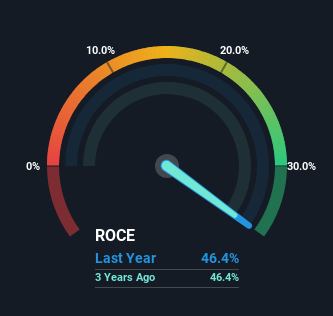Here's What Home Depot's (NYSE:HD) Strong Returns On Capital Mean
If we want to find a stock that could multiply over the long term, what are the underlying trends we should look for? Firstly, we'd want to identify a growing return on capital employed (ROCE) and then alongside that, an ever-increasing base of capital employed. Ultimately, this demonstrates that it's a business that is reinvesting profits at increasing rates of return. Ergo, when we looked at the ROCE trends at Home Depot (NYSE:HD), we liked what we saw.
Understanding Return On Capital Employed (ROCE)
Just to clarify if you're unsure, ROCE is a metric for evaluating how much pre-tax income (in percentage terms) a company earns on the capital invested in its business. The formula for this calculation on Home Depot is:
Return on Capital Employed = Earnings Before Interest and Tax (EBIT) ÷ (Total Assets - Current Liabilities)
0.46 = US$24b ÷ (US$76b - US$25b) (Based on the trailing twelve months to April 2023).
Therefore, Home Depot has an ROCE of 46%. That's a fantastic return and not only that, it outpaces the average of 14% earned by companies in a similar industry.
View our latest analysis for Home Depot
In the above chart we have measured Home Depot's prior ROCE against its prior performance, but the future is arguably more important. If you'd like to see what analysts are forecasting going forward, you should check out our free report for Home Depot.
What The Trend Of ROCE Can Tell Us
In terms of Home Depot's history of ROCE, it's quite impressive. The company has consistently earned 46% for the last five years, and the capital employed within the business has risen 79% in that time. Now considering ROCE is an attractive 46%, this combination is actually pretty appealing because it means the business can consistently put money to work and generate these high returns. If Home Depot can keep this up, we'd be very optimistic about its future.
The Bottom Line On Home Depot's ROCE
Home Depot has demonstrated its proficiency by generating high returns on increasing amounts of capital employed, which we're thrilled about. And since the stock has risen strongly over the last five years, it appears the market might expect this trend to continue. So while investors seem to be recognizing these promising trends, we still believe the stock deserves further research.
On a final note, we've found 1 warning sign for Home Depot that we think you should be aware of.
High returns are a key ingredient to strong performance, so check out our free list ofstocks earning high returns on equity with solid balance sheets.
Have feedback on this article? Concerned about the content? Get in touch with us directly. Alternatively, email editorial-team (at) simplywallst.com.
This article by Simply Wall St is general in nature. We provide commentary based on historical data and analyst forecasts only using an unbiased methodology and our articles are not intended to be financial advice. It does not constitute a recommendation to buy or sell any stock, and does not take account of your objectives, or your financial situation. We aim to bring you long-term focused analysis driven by fundamental data. Note that our analysis may not factor in the latest price-sensitive company announcements or qualitative material. Simply Wall St has no position in any stocks mentioned.
Join A Paid User Research Session
You’ll receive a US$30 Amazon Gift card for 1 hour of your time while helping us build better investing tools for the individual investors like yourself. Sign up here

 Yahoo Movies
Yahoo Movies 
